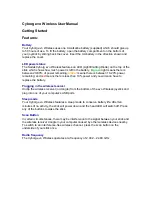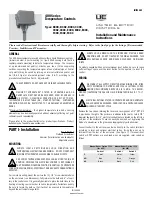MC34067, MC33067
http://onsemi.com
9
The minimum frequency is programmed by R
OSC
using
Equation 1:
ȏ
ǒ Ǔ
COSC
where t
PD
is the internal propagation delay.
(eq. 1)
R
1
ƒ
t
PD
n
C
t
70 ns
0.348
−
=
=
−
OSC
(min)
(max)
OSC
5.1
3.6
The maximum oscillator frequency is set by the current
through resistor R
VFO
. The current required to discharge
C
OSC
at the maximum oscillator frequency can be calculated
by Equation 2:
COSC
1.5C
(eq. 2)
OSC
I
1
ƒ
5.1
−
3.6
=
=
(max)
(max)
ƒ
(max)
The discharge current through R
OSC
must also be known
and can be calculated by Equation 3:
ƒ
(min)
COSC
ROSC
1.5
ε
I
1
ƒ
5.1
−
3.6
=
(min)
R
ROSC
COSC
ROSC
=
ROSC
ε
1
−
−
ǒ
Ǔ
ǒ
Ǔ
OSC
(eq. 3)
Resistor R
VFO
can now be calculated by Equation 4:
R
=
VFO
I(max) IR
−
2.5
−
VEAsat
OSC
(eq. 4)
One
−
Shot Timer
The One
−
Shot is designed to disable both outputs
simultaneously providing a deadtime before either output is
enabled. The One
−
Shot capacitor (C
T
) is charged
concurrently with the oscillator capacitor by transistor Q1,
as shown in Figure 16. The one
−
shot period begins when the
oscillator comparator turns off Q1, allowing C
T
to
discharge. The period ends when resistor R
T
discharges C
T
to the threshold of the One
−
Shot comparator. The lower
threshold of the One
−
Shot is 3.6 V. By choosing C
T
, R
T
can
by solved by Equation 5:
ǒ Ǔ
5.1
3.6
CT
R
t
OS
C
0.348
=
=
T
T
t
OS
ȏ
n
(eq. 5)
Errors in the threshold voltage and propagation delays
through the output drivers will affect the One
−
Shot period.
To guarantee accuracy, the output pulse of the control chip
is trimmed to within 5% of 250 ns with nominal values of R
T
and C
T
.
The outputs of the Oscillator and One
−
Shot comparators
are OR’d together to produce the pulse t
OS
, which drives the
Flip
−
Flop and output drivers. The output pulse (t
OS
) is
initiated by the Oscillator and terminated by the One
−
Shot
comparator. With zero voltage resonant mode converters,
the oscillator discharge time should never be set less than the
one
−
shot period.
Error Amplifier
A fully accessible high performance Error Amplifier is
provided for feedback control of the power supply system.
The Error Amplifier is internally compensated and features
dc open loop gain greater than 70 dB, input offset voltage of
less than 10 mV and a guaranteed minimum gain
−
bandwidth
product of 2.5 MHz. The input common mode range extends
from 1.5 V to 5.1 V, which includes the reference voltage.
Figure 17. Error Amplifier and Clamp
R
VFO
Oscillator
Control Current
3.1 V
Error Amp Output
Noninverting Input
Inverting Input
Error
Amp
I
OSC
7
8
6
3
Error Amp
Clamp
When the Error Amplifier output is coupled to the I
OSC
pin by R
VFO
, as illustrated in Figure 17, it provides the
Oscillator Control Current, I
OSC
. The output swing of the
Error Amplifier is restricted by a clamp circuit to improve
its transient recovery time.
Output Section
The pulse(t
OS
), generated by the Oscillator and One
−
Shot
timer is gated to dual totem
−
pole output drives by the
Steering Flip
−
Flop shown in Figure 18. Positive transitions
of t
OS
toggle the Flip
−
Flop, which causes the pulses to
alternate between Output A and Output B. The flip
−
flop is
reset by the undervoltage lockout circuit during startup to
guarantee that the first pulse appears at Output A.
Figure 18. Steering Flip
−
Flop and Output Drivers
Output A
R
12
13
14
Output B
Power Ground
Q
Q
T
Steering
Flip-Flop
PWR
GND
V
CC
V
CC
PWR
GND
Downloaded from
Elcodis.com
electronic components distributor


















